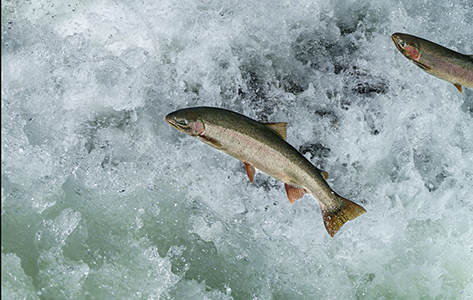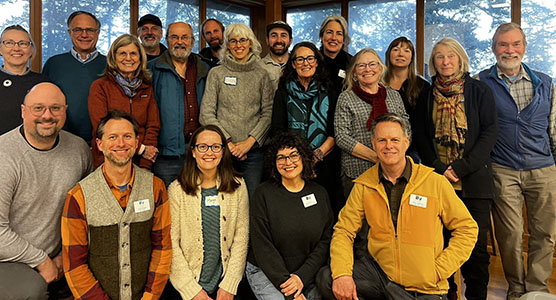— by Janet Alderton —
An open letter to Councilors Rick Hughes, Bob Jarman, and Jamie Stephens,
I talked with Councilor Hughes this last week.
He and I hope that the proposed language in the Shoreline Master Program Goals and Policies that removes a prohibition on cross-Sound underwater oil pipelines can be changed to create prohibitions on both oil and natural gas underwater cross-Sound pipelines in San Juan County.
Rick has suggested the following language that I support:
“Prohibit on-shore, over-water, and underwater facilities for the refining and shipment of oil and natural gas.”
Thank-you, Councilor Hughes for this concise language that will help protect our islands for the people who love them and for the creatures who do not have access to the internet.
Another part of our conversation was about protecting our shorelines for people and for nature. Rick rightly pointed out that he had no part in crafting or adopting the regulations in the existing Critical Areas Ordinance. Still, the current Council is proposing to adopt (by reference) portions of the Critical Areas Ordinance into the Shoreline Master Program update that will govern Shoreline Water Quality Buffers and Fish and Wildlife Habitat Conservation Buffers. Rick is right that these regulations have withstood legal challenge both from those who found the regulations inadequate for protecting water quality and fish and wildlife habitats and challenges from those who found the regulations too restrictive for land owners wanting to develop their land without taking into account that some approaches to development have greater negative impacts than others.
I am still extremely concerned that the Critical Areas Ordinance provisions that are proposed to be adopted directly into the Shoreline Master Program will give people a roadmap to destruction of our critical shoreline habitats. Rick tried to assure me that people in the San Juan Islands will not take repeated advantage of provisions that allow destruction of 40% of the tree volume every ten years and removal of 20% of the tree branches each year. He thinks that the Mar Vista clear-cutting of the shoreline on San Juan Island was a unique event, and that everyone else in our county will understand the value that shoreline trees and shrubs have for our salmon and orca whales.
I would like to believe this. Still, I am skeptical when I look at what has transpired historically. There still exists an esthetic that values a home with a lawn stretching to the shoreline unobstructed by native trees or shrubs. One finds this esthetic manifest in Polaris images of San Juan County shoreline properties. I have attached some examples from my home island, Orcas. One of these examples has mown grass that extends to the edge of a Feeder Bluff. This is “grandfathered in” I suppose, but the proposed Shoreline Master Plan encourages people who wish to approach this extreme. For stands of Douglas fir, the CAO regulations allow the canopy to be reduced by 79% in Fish and Wildlife Habitat Conservation Areas. The forest understory is not protected at all -except for shrubs lucky enough to be over-hanging the actual Ordinary High Water Mark of our marine waters.
I looked on Polaris for examples of orchards or vegetable gardens on Orcas Island located 60 feet from our shorelines because the Critical Areas Ordinance allows fenced orchards and gardens in the outer 25% of the Water Quality Buffer. I have not found any. This is likely because people create orchards and vegetable gardens where there is enough soil and water for them to flourish. Our rocky shorelines and our eroding Feeder Bluffs are not places where a vegetable garden or orchard will flourish. So I can only conclude that the provision that allows 4000 square feet of fenced garden or orchard in the outer 25% of a shoreline water quality buffer will serve people who want an excuse to remove more native trees and shrubs from our shorelines.
Lastly, Rick listened to an arborist who is thinning my forest to promote the health of the trees that are over-crowded due to historic cycles of clear-cutting combined with fire suppression. The shoreline zone is not involved because I live above a very high cliff that I wish to remain undisturbed. The arborist talked about the problems with the previous Shoreline Master Program regulations for promoting healthy forest ecology and esthetic tree pruning. But he also thinks that the proposed regulations will be extremely confusing to implement and will promote the decline of shoreline trees, if that is what the property owner wishes. Rick really cares about helping local businesses thrive, and he plans to have further discussions with the arborist about the proposed regulations.
But, it is my distinct impression that our County Councilors are weary and wish to put the Shoreline Master Program behind them. I understand. I too am weary. Still, the mandate of the Shoreline Master Plan is to protect our shorelines for people and for nature. I feel that the proposed regulations fall far short of this goal. Allowing a new house, its septic system, and its well in what is supposed to be a Fish and Wildlife Habitat Conservation buffer does not make sense to me. Allowing a 4000 square foot garden or orchard in the Water Quality Buffer does not make sense to me. Allowing the harvest of 40% of the trees over six inches in trunk diameter every ten years and the pruning of 20% of the foliage every year seems more like a Tree Destruction Zone than a Tree Protection Zone.
I hope that our County Council has the wisdom to take the long view for our county’s people and natural wonders. I hope that they will choose to better protect our shoreline Water Quality Buffers and Fish and Wildlife Habitat Conservation Areas.
Janet Alderton
Deer Harbor
Orcas Island
The Salish Sea
Washington State
Planet Earth
**If you are reading theOrcasonian for free, thank your fellow islanders. If you would like to support theOrcasonian CLICK HERE to set your modestly-priced, voluntary subscription. Otherwise, no worries; we’re happy to share with you.**








Four years, several hundreds of thousands of dollars, and endless hours of meetings is hardly rushing. That said, the CAO and the proposed SMP are impossible to decipher, make any “development” (read building a house) very expensive, and accomplish little or nothing more than their predecessors in the way of protection.
Thank you Janet for your substantial efforts in helping to protect our environment, and thank you to Rick for always being open to listening to constituents.
” Rick tried to assure me that people in the San Juan Islands will not take repeated advantage of provisions that allow destruction of 40% of the tree volume every ten years and removal of 20% of the tree branches each year. He thinks that the Mar Vista clear-cutting of the shoreline on San Juan Island was a unique event, and that everyone else in our county will understand the value that shoreline trees and shrubs have for our salmon and orca whales.”
Sounds like Rick still has some common sense, a rare commodity these days. Another concept that seems to have all but disappeared around here is individual private property owner rights.
I agree with you Peg.
The regulations are very difficult to decipher.
They could be much much simpler and much more protective for salmon and orcas.